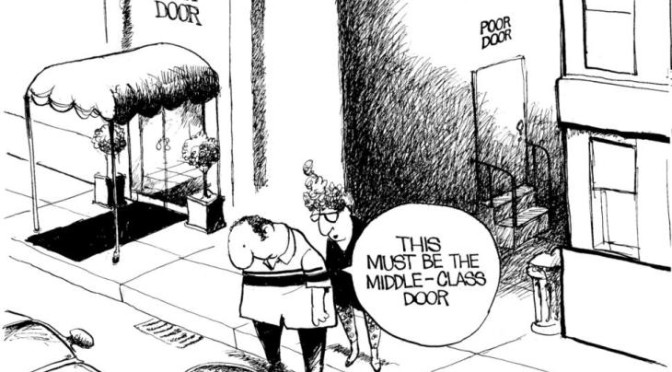1. LEED does not promote good practice of sustainability
- Quirk, Vanessa. “Where is LEED Leading Us?…And Should We Follow?” 23 Apr 2012. ArchDaily. Accessed 25 Jan 2015.
- Denzer, Anthony S (02/2011). “The Limitations of LEED: A Case Study”. Journal of green building (1552-6100), 6 (1), p. 25.
- Guy R. Newsham, Sandra Mancini, Benjamin J. Birt, Do LEED-certified buildings save energy? Yes, but…, Energy and Buildings, Volume 41, Issue 8, August 2009, Pages 897-905, ISSN 0378-7788.
- Bray, Jeremy (10/01/2006). “Unintended consequences: how the use of LEED can inadvertently fail to benefit the environment”. Journal of green building (1552-6100), 1 (4), p. 152.
- Wargo, John. “LEED Building Standards Fail to Protect Human Health” Yale Environment 360. 16 August 2010. Web. 25 January 2015.
- “Tumult Grows Over LEED Rating System Update.” – News. Web. 25 Jan. 2015.
2. Using local ‘non green’ materials is more sustainable than imported ‘green’ materials
- Kacmar, Donna (03/01/2014). “Materials and sustainability: the Materials Research Collaborative at the University of Houston seeks to be a leader in bringing innovative materials to the local architectural community.” Texas architect (0040-4179), 64 (2), p. 13.
- “Choosing Green Materials and Products.” Green Building. EPA. 19 December 2012. Web. 25 January 2015.
- Katona, Vilmos (04/01/2013). “ECO-SPIRIT: sustainable development and environmental awareness in contemporary liturgical planning.”. A Z: ITU journal of Faculty of Architecture, 10 (1), p. 117.
- Kayode, Oloruntoba and Olusegun, Ayodele E. “Local Building Materials: a Tool Towards Effective Low-Income Housing in Nigeria.” Middles East Journal of Scientific Research. 2013. Web. 25 January 2015.
- Hollis, Rob. “Local Materials Sourcing in Contemporary Architecture.” University of Colorado Boulder. Spring 2014. Web. 25 January 2015.
- Roux, Pierre and Alexander, Alex. “SUSTAINABLE BUILDING MATERIALS” Chapter 3. Web. 25 January 2015.
3. Health and environmental calamities can be greatly resourced and helped by responsible architects through architectural means and procedures.
- “Butaro Hospital / MASS Design Group” 06 Sep 2011. ArchDaily. Web. Accessed 25 Jan 2015.
- “Building Green in Sakhnin.” Israel Environment Bulletin. TAEQ Organization, 2010. Web. Acessed 25 Jan 2015.
- Tomasulo, Matt. Walk [Your City]. Walk [Your City]. 2015. Web. Accessed 25 Jan 2015 <https://walkyourcity.org/>.
- SWINE. “Can City.” SWINE. SWINE. 2013. Web. Acessed 25 Jan 2015.
- “Informal Urban Communities Initiative.” University of Washington. 2014. Architects w/o Borders-Seattle. Web. Accessed 25 Jan 2015.
- Architecture sans frontieres. ASF International .2015. Web. Accessed 25 Jan 2015 <http://www.asfint.org/>.
4. Food security and scarcity is a rising and current issue in Asia, in which architecture is the key solution to the problem and benefit in various scales.
- Rosenfield, Karissa. “SPARK Proposes Vertical Farming Hybrid to House Singapore’s Aging Population” 01 Dec 2014. ArchDaily. Accessed 25 Jan 2015.
- “Food Security in Asia and the Changing Role of Rice.” Occasional Paper. The Asia Foundation. 4 October 2010. Web. Accessed 25 Jan 2015.
- Doucleff, Michaeleen. “Sky-High Vegetables: Vertical Farming Sprouts in Singapore.” The salt. NPR. 09 November 2012. Web. Accessed 25 Jan 2015.
- “Nuvege.” Agritecture. Agritecture. 2013. Web. Accessed 25 Jan 2015.
- Strother, Jason. “South Korea Researches Vertical Farming for Food Security.” Voice of America. 04 April 2012. Web. Accessed 25 Jan 2015.
- Jander, Mary. “Asia: Vertical Farming Tested.” UBM’s Future Cities. 15 August 2013. Web. Accessed 25 Jan 2015.
5. Computers and computer aided design have expanded the realm of architectural design
- Terzidis, Kostas. “THE ROLE OF COMPUTERS IN ARCHITECTURAL DESIGN.” Web. 25 January 2015.
- Celento, David. “Innovate or Perish.” Harvard Design Magazine. 2007. Web. 25 January 2015.
- Yehuda E. Kalay, “Redefining the role of computers in architecture: from drafting/modelling tools to knowledge-based design assistants“, Computer-Aided Design, Volume 17, Issue 7, September 1985, Pages 319-328, ISSN 0010-4485.
- Pagnotta, Brian. “AD Classics: The Guggenheim Museum Bilbao / Frank Gehry” 01 Sep 2013. ArchDaily. Accessed 25 Jan 2015.
- Peters, Brady. “How Technology is Changing Architecture.” The Creates Project. Vice. 12 Apr 2013. Web. Accessed 25 Jan 2015.
- Barbos, Alex. “Advantages of CAD: 5 Reasons to Go Digital.” UDEMY Blog. 04 June 2014. Web. Accessed 25 Jan 2015.
